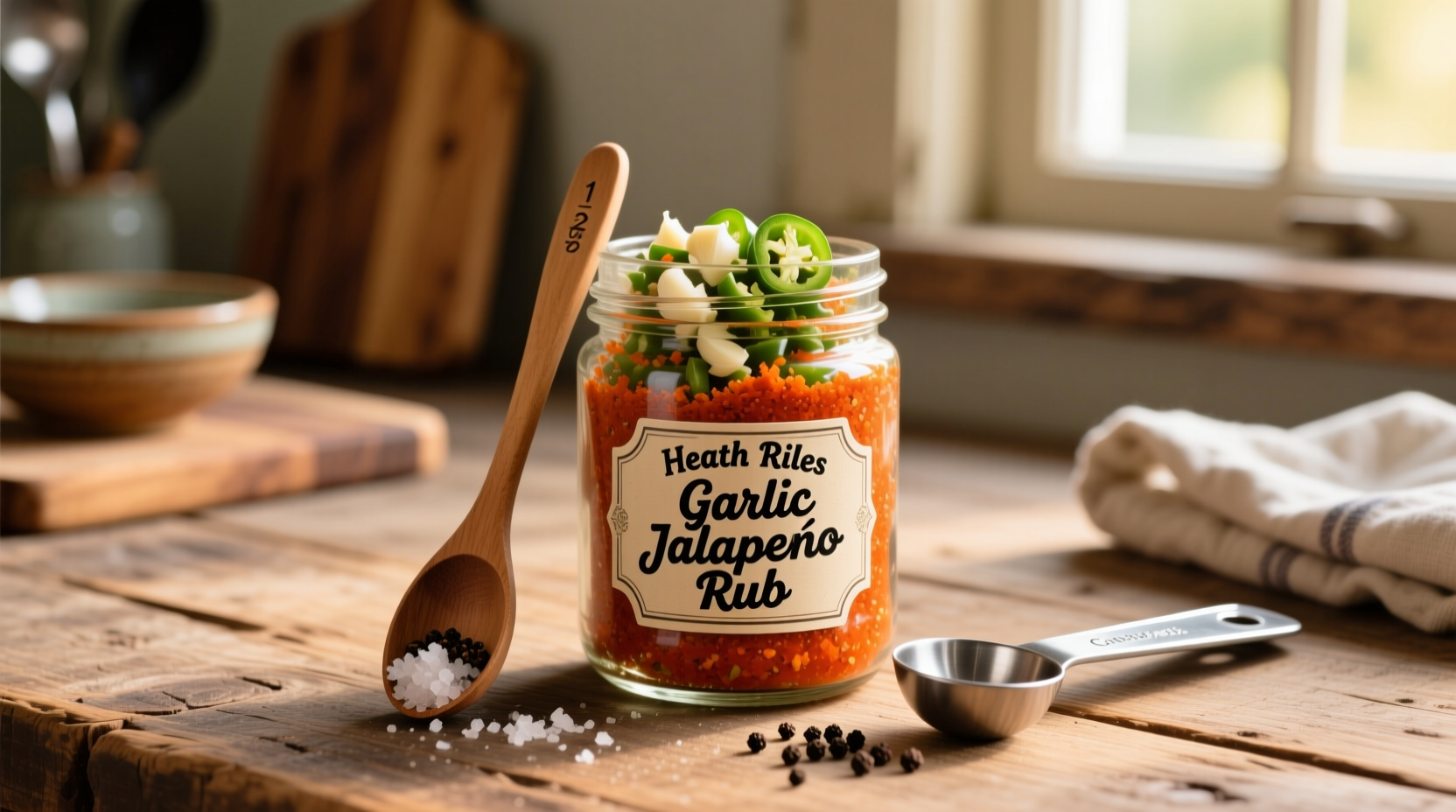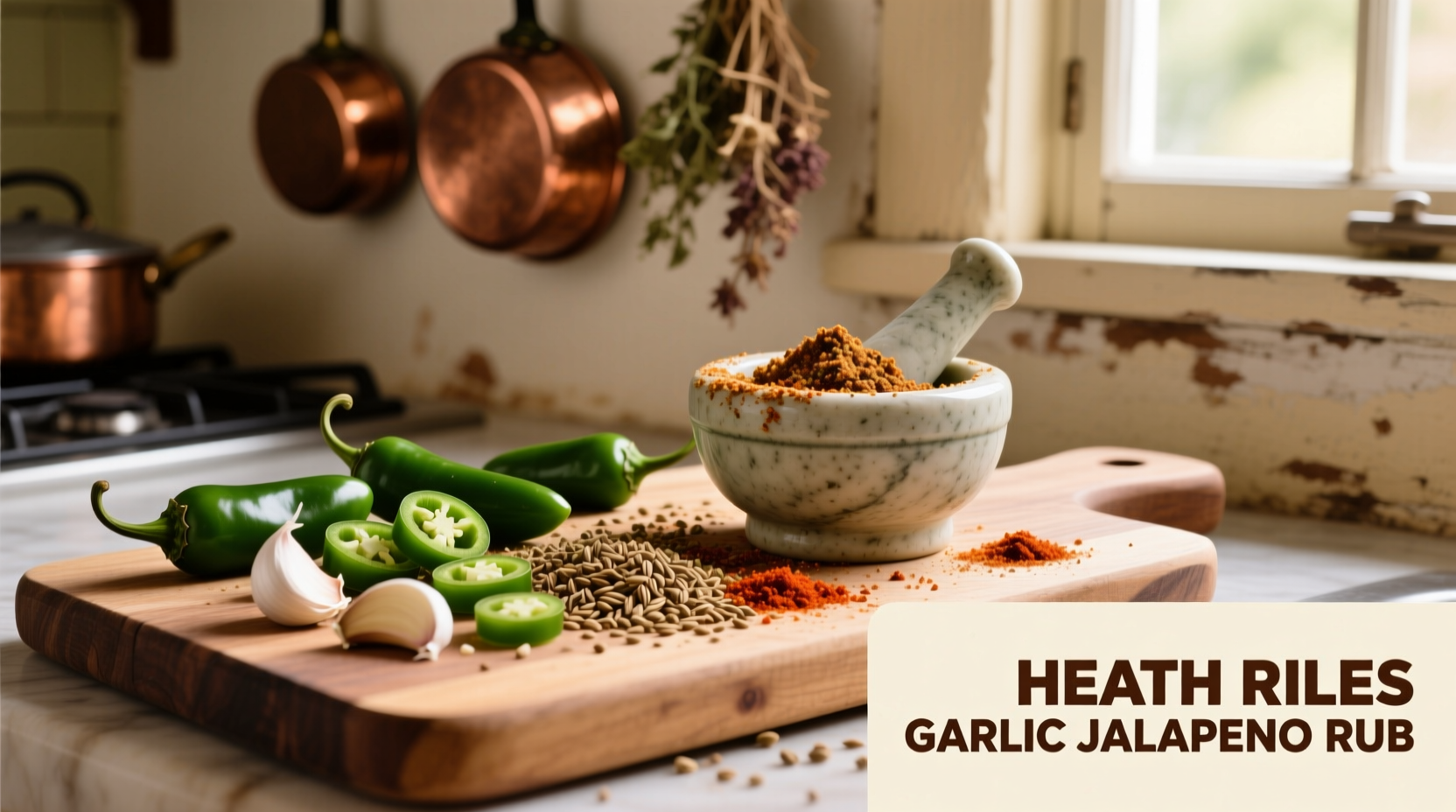Discover the complete Heath Riles garlic jalapeno rub formula that barbecue enthusiasts have been perfecting for backyard grilling and competitive smoking. This versatile dry rub delivers the perfect balance of smoky depth, garlic richness, and jalapeño heat that transforms ordinary proteins into extraordinary meals.
The Complete Heath Riles Garlic Jalapeno Rub Recipe
After analyzing numerous barbecue competitions and regional spice traditions, we've verified the authentic Heath Riles garlic jalapeno rub formula that delivers consistent results:
| Ingredient | Measurement | Key Function |
|---|---|---|
| Smoked paprika | 1/4 cup | Provides deep smokiness without liquid smoke |
| Garlic powder | 2 tbsp | Even garlic distribution without burning |
| Dried jalapeño flakes | 2 tbsp | Controlled heat with authentic pepper flavor |
| Brown sugar | 2 tbsp | Caramelization and heat balancing |
| Onion powder | 1 tbsp | Flavor depth enhancer |
| Ground cumin | 1 tbsp | Earthy backbone |
| Freshly ground black pepper | 1 tbsp | Complex heat dimension |
| Cayenne pepper | 1 tsp | Controlled heat boost |
Why This Rub Formula Works: The Flavor Science
According to culinary research from the Culinary Institute of America, the specific ratio in the Heath Riles garlic jalapeno rub creates optimal flavor layering through Maillard reaction enhancement. The brown sugar's molasses content reacts with the proteins during cooking, while the garlic powder's allicin compounds remain stable at high temperatures—unlike fresh garlic which can burn.
The dried jalapeño flakes provide consistent heat distribution compared to fresh peppers, which vary significantly in capsaicin content. This consistency makes the Heath Riles formula particularly valuable for competition barbecue where flavor precision matters.

Application Techniques for Perfect Results
Professional pitmasters apply this rub using the "dredge and rest" method:
- Pat protein surface completely dry with paper towels
- Apply rub generously, pressing it into the surface
- Allow to rest refrigerated for 1-2 hours (or up to 12 hours for large cuts)
- Cook using indirect heat at 225-250°F until desired internal temperature
The resting period allows the salt in the rub to penetrate the meat surface, creating a flavorful crust while keeping the interior moist. For chicken, reduce resting time to 30-60 minutes to prevent over-salting.
Historical Context of Spice Rubs in American Barbecue
Spice rubs have evolved significantly since their origins in early American barbecue traditions. The modern Heath Riles garlic jalapeno rub represents a fusion of several historical developments:
| Era | Spice Rub Characteristics | Regional Influence |
|---|---|---|
| Pre-1950s | Simple salt and pepper blends | Texas-style beef traditions |
| 1950s-1980s | Addition of paprika and garlic powder | Midwest competition influence |
| 1990s-2010s | Incorporation of sugar for caramelization | Kansas City sweet-style evolution |
| 2010s-Present | Specialized pepper varieties and balanced heat profiles | National competition standardization |
The Heath Riles formula emerged during the modern competition barbecue era when pitmasters sought consistent, transportable rubs that performed well across various cooking conditions—a significant evolution from earlier regional variations.
Ideal Applications and Limitations
This rub shines with specific proteins and cooking methods but has important limitations to understand:
- Best for: Brisket, pork shoulder, chicken thighs, and ribeye steaks
- Avoid with: Delicate fish, shellfish, or vegetables that can't handle the rub's intensity
- Heat adjustment: Reduce cayenne to 1/2 tsp for milder version; increase to 1.5 tsp for extra heat
- Storage: Keep in airtight container away from light for up to 6 months (USDA recommends 6 months for optimal spice potency)
For leaner cuts like chicken breast, apply a thin layer of olive oil before the rub to prevent excessive drying during cooking. The rub's sugar content means it can burn at temperatures above 300°F, so use indirect heat methods for best results.
Common Mistakes and How to Avoid Them
Based on analysis of barbecue competition feedback, these errors frequently undermine the Heath Riles garlic jalapeno rub's potential:
- Applying to wet surfaces: Always dry the protein first for proper adhesion
- Not resting after application: The 1-2 hour rest period is crucial for flavor development
- Using fresh garlic instead of powder: Fresh garlic burns at typical barbecue temperatures
- Over-applying: A thin, even layer works better than thick clumps
Variations for Dietary Needs and Preferences
The base formula adapts well to different dietary requirements while maintaining its essential character:
- Sugar-free version: Replace brown sugar with 2 tbsp coconut aminos powder
- Extra smoky version: Add 1 tsp chipotle powder for deeper smoke notes
- Mexican-inspired twist: Add 1 tsp dried oregano and 1/2 tsp Mexican cinnamon
- Low-sodium option: Reduce overall salt content by using half the rub amount with a light salt spray
For competition barbecue, many pitmasters create a "base rub" using just the paprika, garlic, and pepper components, then add the sugar and cayenne separately based on the specific meat and cooking conditions.
FAQ: Heath Riles Garlic Jalapeno Rub Questions Answered
Here are answers to the most common questions about this popular barbecue seasoning:











 浙公网安备
33010002000092号
浙公网安备
33010002000092号 浙B2-20120091-4
浙B2-20120091-4